In the first leg match of the UEFA Champions League qualifiers, playoffs round Young Boys welcomed Red Star Belgrade in the battle for group stage qualification. The home team was in a better place before the game since they were seen as favourites since they started competing with the “elite” from the last round of qualifications.
Vladan Milojević’s men were in a difficult position due to suspensions and injuries but they managed to secure a good result for the upcoming fixture that will take place in Serbia. This tactical analysis will show you how the Red and Whites got away with just a draw even though they were in the lead for the good part of the match.
Lineups
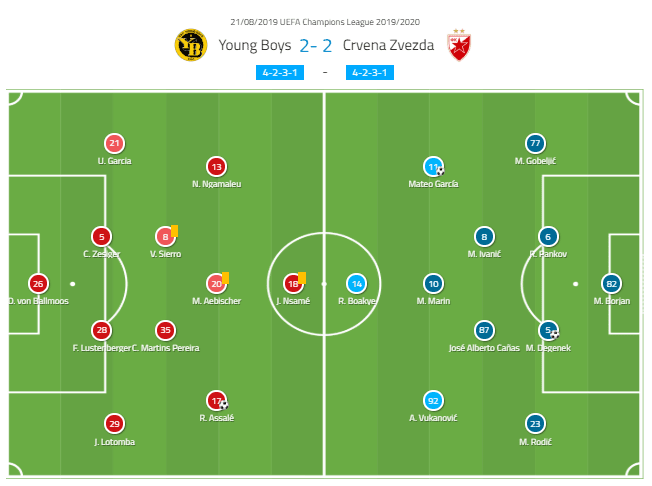
Gerardo Seoane set up his team in the 4-2-3-1 formation with a lot of midfield transformations throughout the game. The keys to his team’s attacks were in hands of Michel Aebischer and Christopher Martins Pereira who were in control of the middle of the pitch. Their main threat was Jean Pierre Nsame who was the lone striker and had wing support from Roger Assale on one side, and Ngoumo Ngamaleu on the other.
The Serbian champions went into the match with the same tactics and formation as their rivals did, but the lineup went through a lot of changes because of the unavailability of some regular starters. Mirko Ivanić was playing along with José Alberto Cañas in the centre of the midfield replacing suspended Dušan Jovančić, and the main attacking forces of the team were the captain Marko Marin and their latest signing Mateo Garcia with Richmond Boakye on top of the squad.
Red Star’s attacking patterns
The away team came to Switzerland with a clear attitude to get themselves a good result for the second leg in Belgrade. Even though they had a slower start of the match, they quickly reorganised their lines and went to become dangerous in front of the hosts’ goal.
Milojević pointed out his wingers as their most important attacking players and they continued to drift inwards and position themselves in the half-spaces. Since Marin once again had the freedom to roam all over the field, Aleksa Vukanović and Mateo Garcia were strict in positioning close to Boakye and filling the inner-corridor rooms.
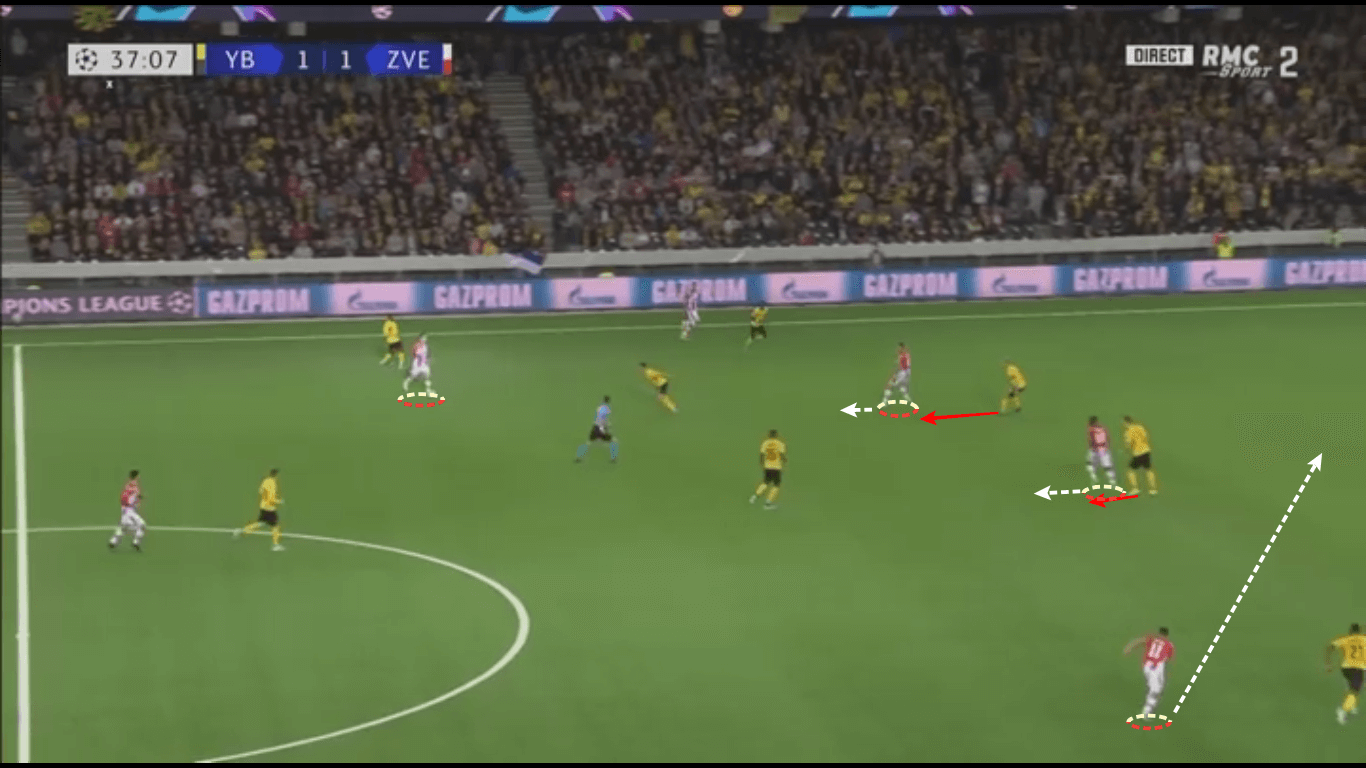
As we can see in the picture above, Red Star’s wingers were set up in those spaces helping Boakye and also providing pass options for the player in possession. Out of those situations, the two of the front three frequently sat still or even went lower on the pitch in order to drag the opposition out of their comfort zone. That meant for the furthest of them to go with the run-in into the emptied space, as it is shown that the Argentinean did.
Also, the wingers went with the runs from the inside to the sidelines when the Young Boys’ full-backs were higher and out of their position. Vukanović and Garcia sensed the space pretty good and were often served with good through balls into the spaces on the flanks from where they attempted crosses or return-passes to the box.
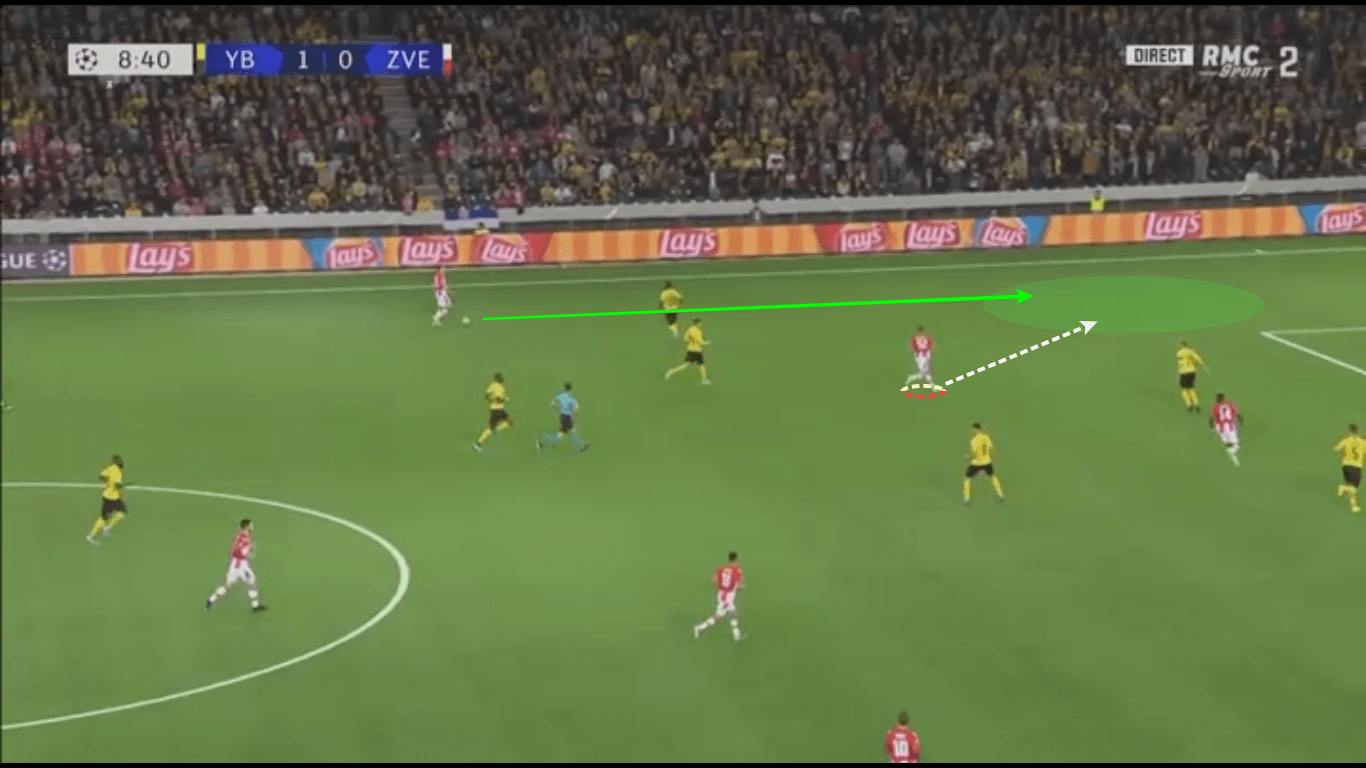
Both of the wide players in Crvena Zvezda’s team made runs out of the half-spaces and received possession from their wide defenders and Marin who used to pull himself to the flanks time to time. He was the player who started the majority of the visitors’ actions. The inside-positioning of Milojević’s wingers also opened the room next to the sidelines for their full-backs to overlap, since the opposition’s attention was usually focused on the away team’s attackers.
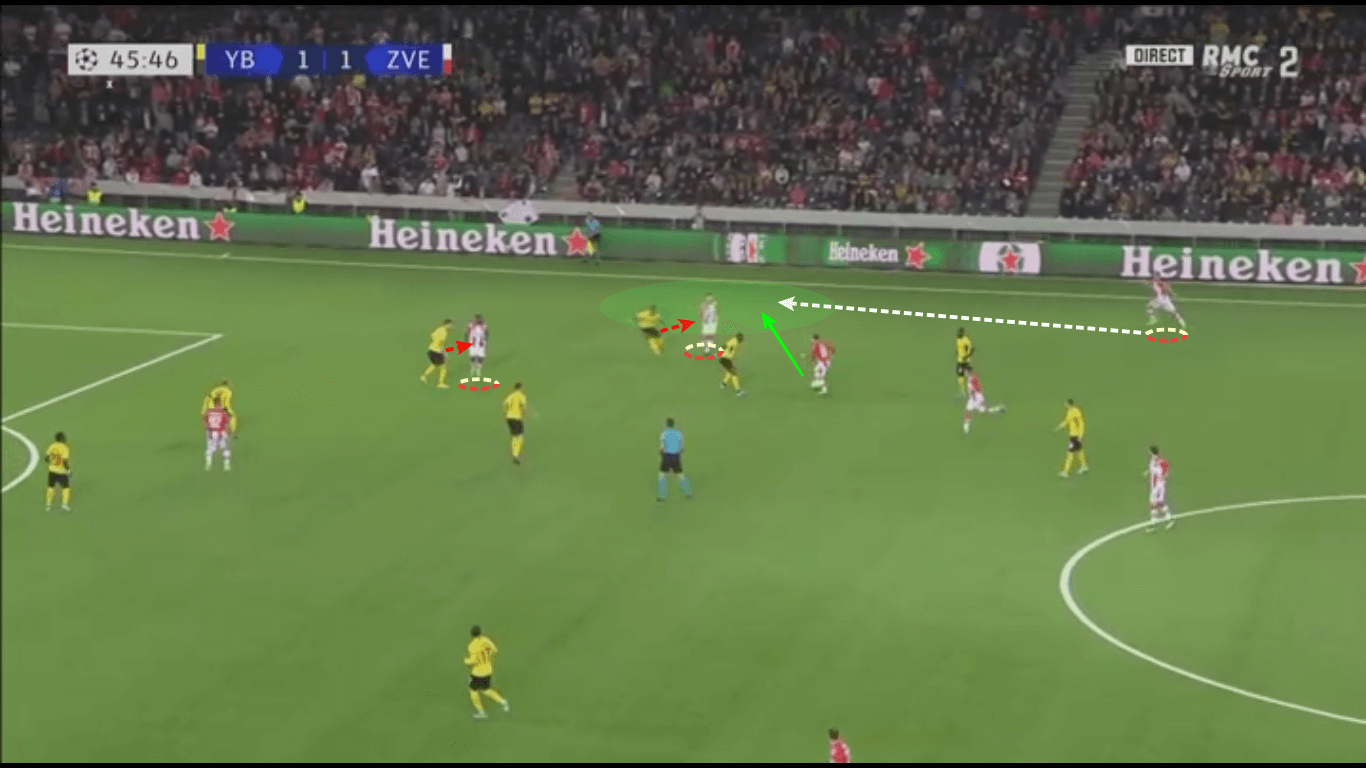
Marko Gobeljić and Milan Rodić played as a support to their forwards, used those situations to attempt crosses, which was one of the Serbians’ main idea how to threaten Young Boys’ goal, but were mainly oriented to their defensive tasks.
Moreover, since Red Star were without Milan Pavkov in this match, they couldn’t play their long-ball tactics at the level they did when he was in the team, to they tended to play it more through the ground with Boakye as the link-up player.
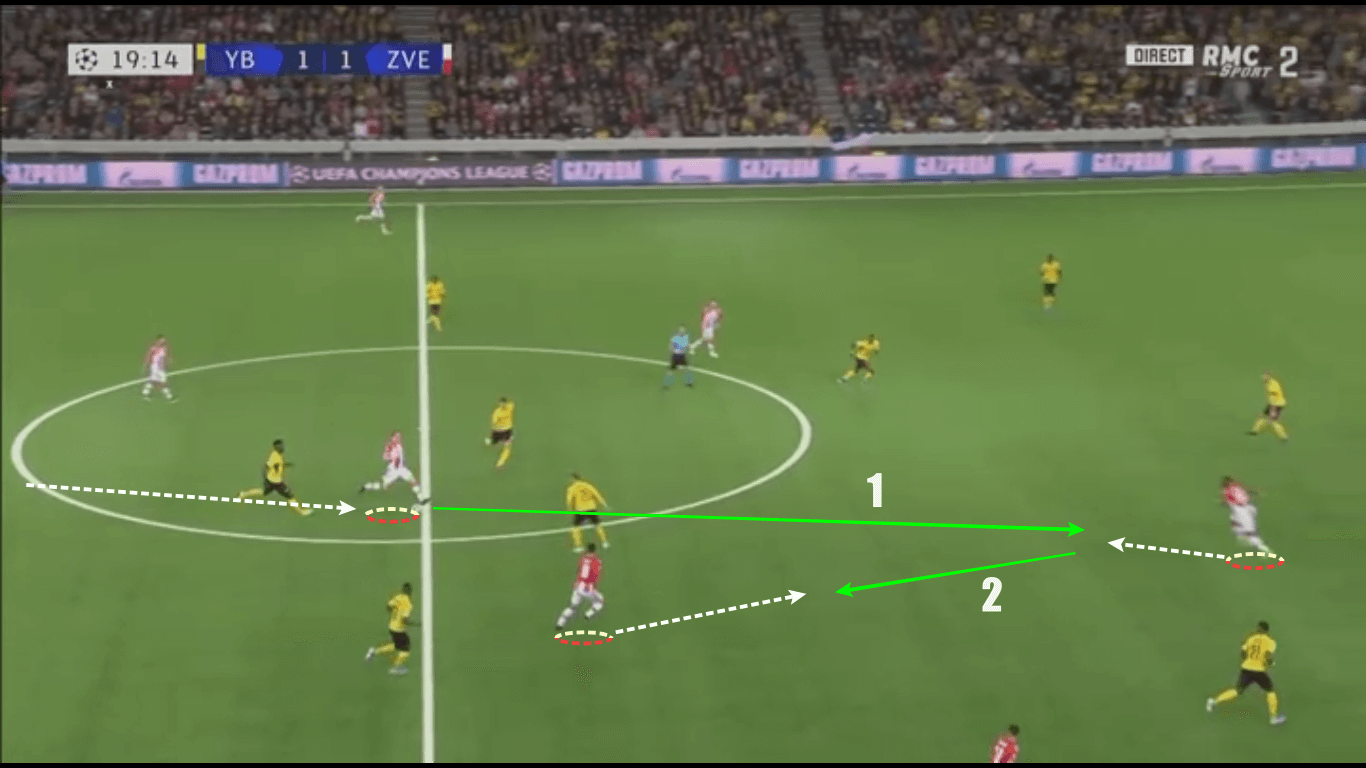
The Ghanaian often dropped to help his team-mates and provide them with an option to break the opposition’s lines. He had the support of his midfielders who came closer to him so he could play backward passes, while Radovan Pankov at times went higher and played good deep balls to his striker out of the defensive line.
The Swiss’ approach
Young Boys went into the match as favourites and showed great energy right from the start. The home team tended to press high and get themselves into the lead which they succeeded in the opening stages of the game.
Their main idea was to stamp their authority on the flanks and aerially to get their chances from long balls and crosses. They tried to get better of the new Red Star’s defence, and use the spaces that were left free due to bad communication between them.
This match was the first Pankov’s start in the European competitions so he lacked experience in the crunch games. He was the guy who was pointed out from Seoane as Zvezda’s weakest link.
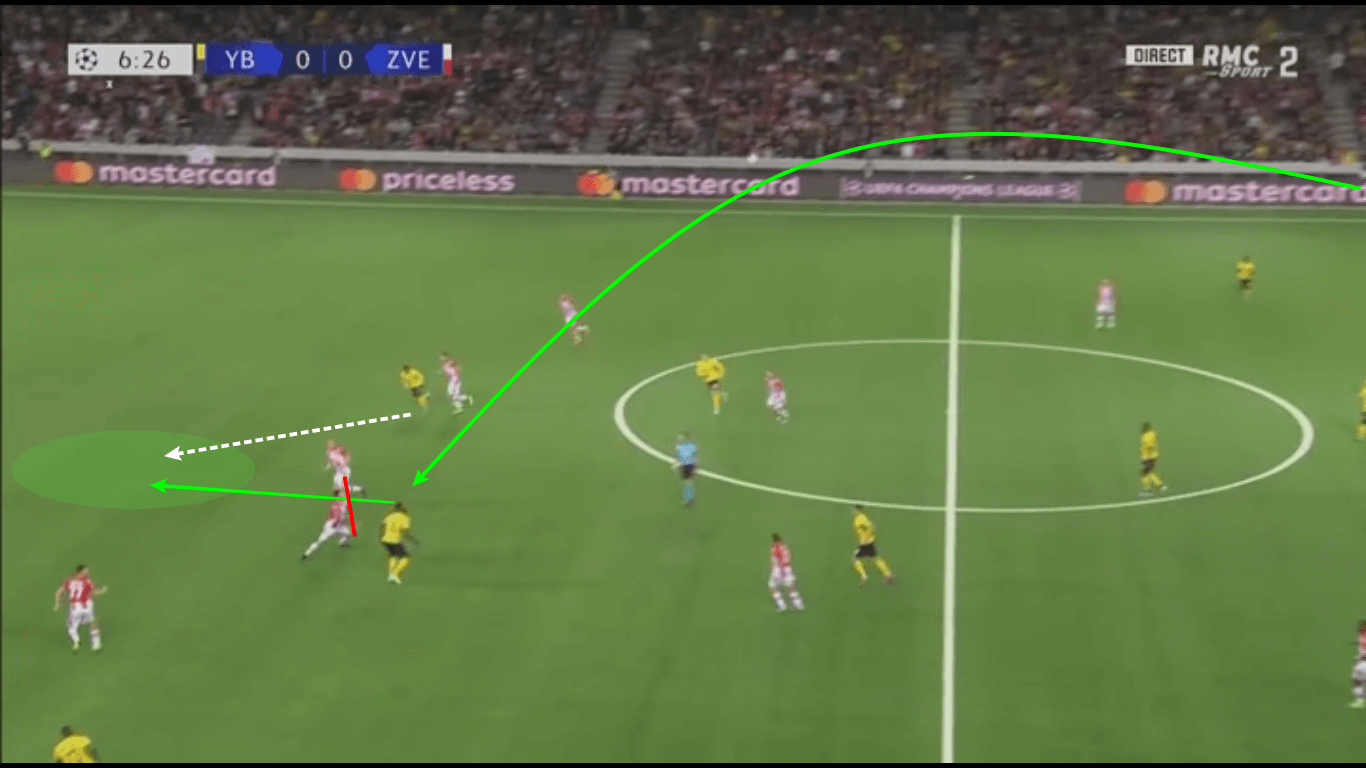
His positioning directly influenced the result since Young Boys managed to catch him out of position in the situation leading to the goal. The centre-backs communication with his team-mates in the defensive line wasn’t at a high level and the Swiss recognised this and overloaded his side with aerial balls based on Nsame’s good jumping and their wingers’ fast run-ins.
The long passes were mostly addressed between the visitors’ right centre-back and right full-back where their striker had superiority in the air over Gobeljić and Pankov, and the wide players had on the ground regarding the pace.
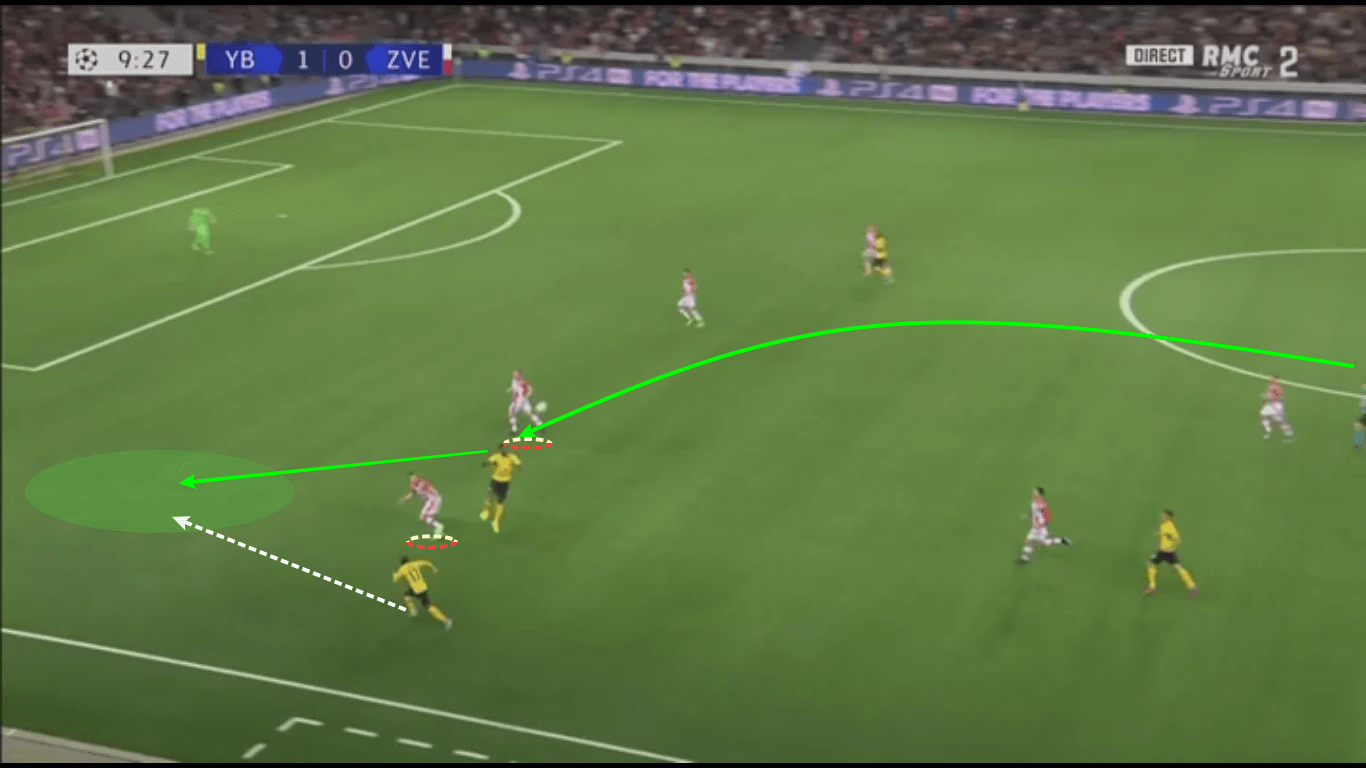
In the picture, it is shown how Young Boys tried to get into good positions with their long balls. Nsame was the one who dropped himself and got to the receiving end of the most passes after what he supplied his team-mates on the flanks with the balls which lead them in “1v1” situations next to the sideline.
Since Red Star sat tight in their low block it wasn’t always possible for the home team to play it this way and then they went with the crosses after circling the well-organised structure of their opponents, but without much success.
They got their chances when Zvezda tried to counter and into transitional offences. The host midfielders were always very near their the action and tended to press in the central zones of the pitch creating surplus positions.
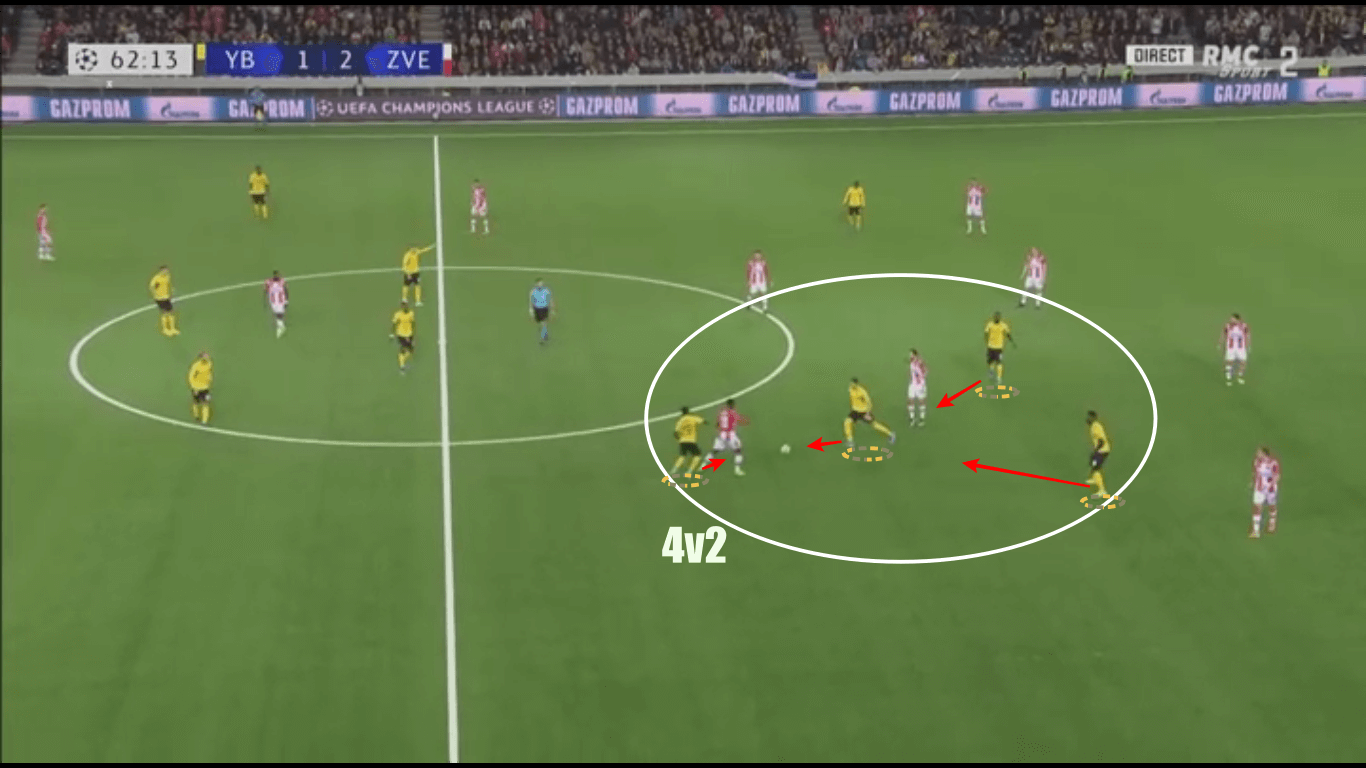
As we can see, Young Boys surrounded the Serbians in the middle of the field and created a “4v2” situation out of which they had a possibility to threaten Milan Borjan’s goal. Those scenarios happened repeatedly in the closing stages of the match when Red Star lost their sharpness and lead them into making mistakes and eventually ending up with just a draw.
Serbian champions’ dense defence
In their past matches, the strongest part of Crvena Zvezda’s game was their tight defensive structure. They have upgraded it since the start of the season and that is the one thing needed to do to compete at a high level.
Unlike the duels against Copenhagen and Helsinki, when they played in a dense central block, their set up was a bit lower in the majority of their match against Young Boys in order to slow their opponents’ attacks.
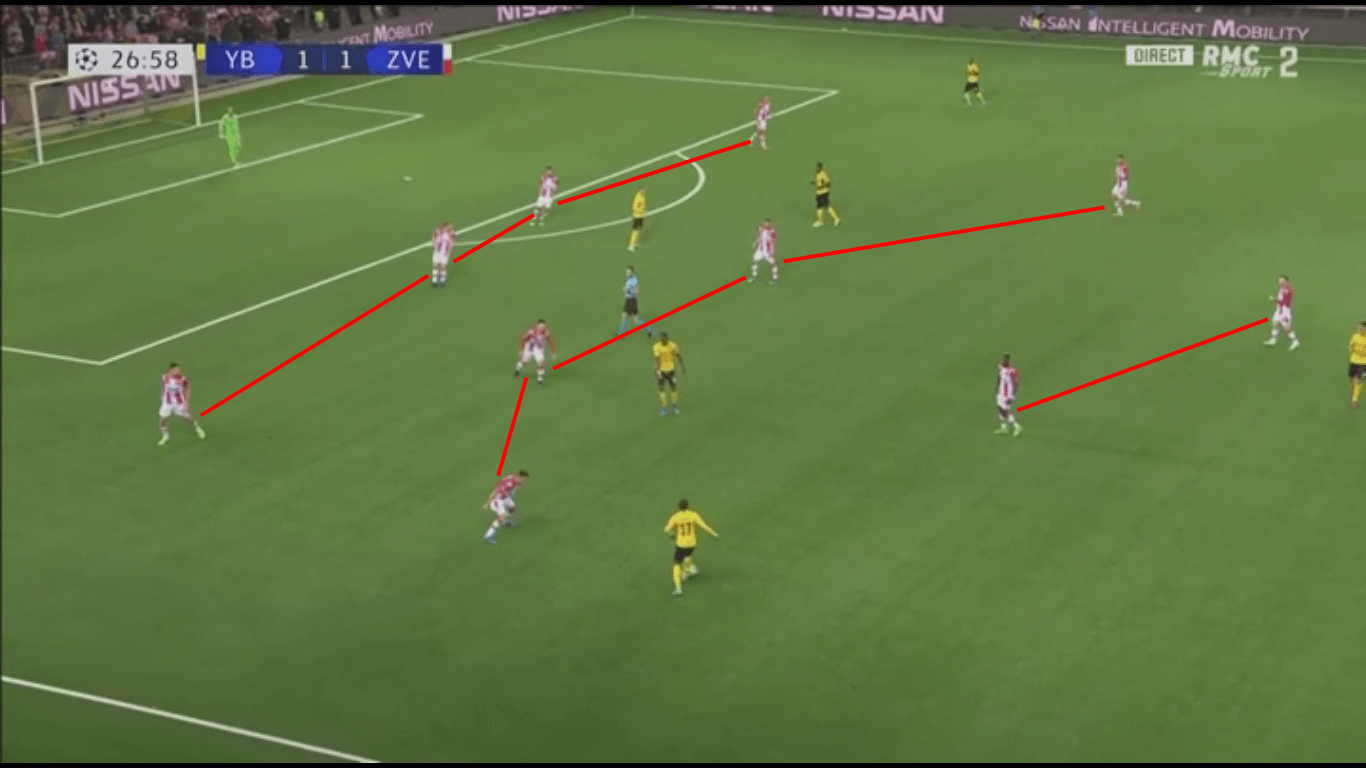
Milojević lowered his side closer to their goal so the concentration of the players in the Swiss’ attacking final third could be higher. That made chance creation more difficult for the home team and forced them into circling the block without finding a break-through option.
The Serbs were more focused on protecting their net throughout the match, trying to secure that decision time take place at their turf. After they got the lead at the beginning of the second half, Zvezda were more defensive and wanted to hold them to a draw.
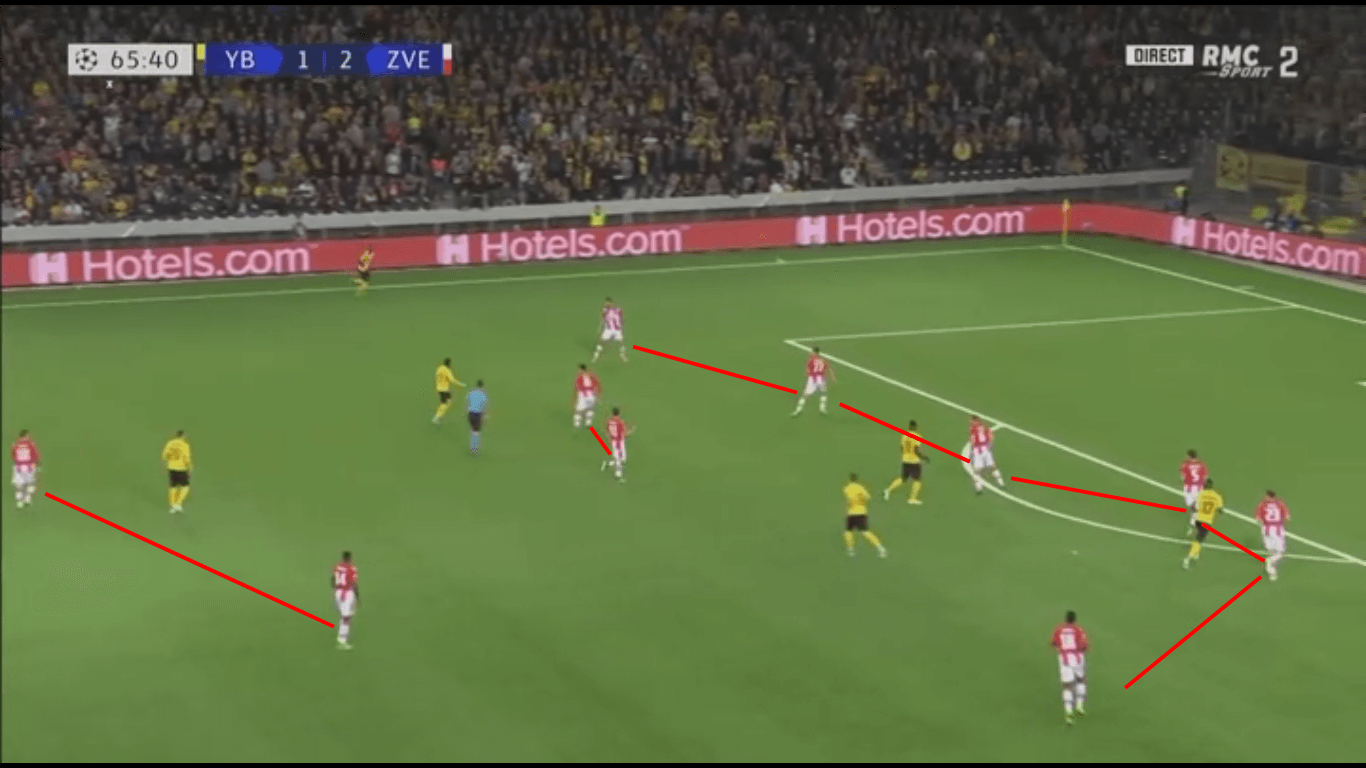
In the image, we can see how Red Star’s 4-4-2 block transformed after the Brazilian stepped into the field. In most parts of the game, the away team’s wingers played as support members to their defensive fellows, which became even more obvious in the last 30 minutes. Jander on one side and Vukanović on the other dropped lower and formed a hybrid 6-2-2 block which was very hard for Young Boys to break down. This lead them to attempt a bunch of crosses to the box.
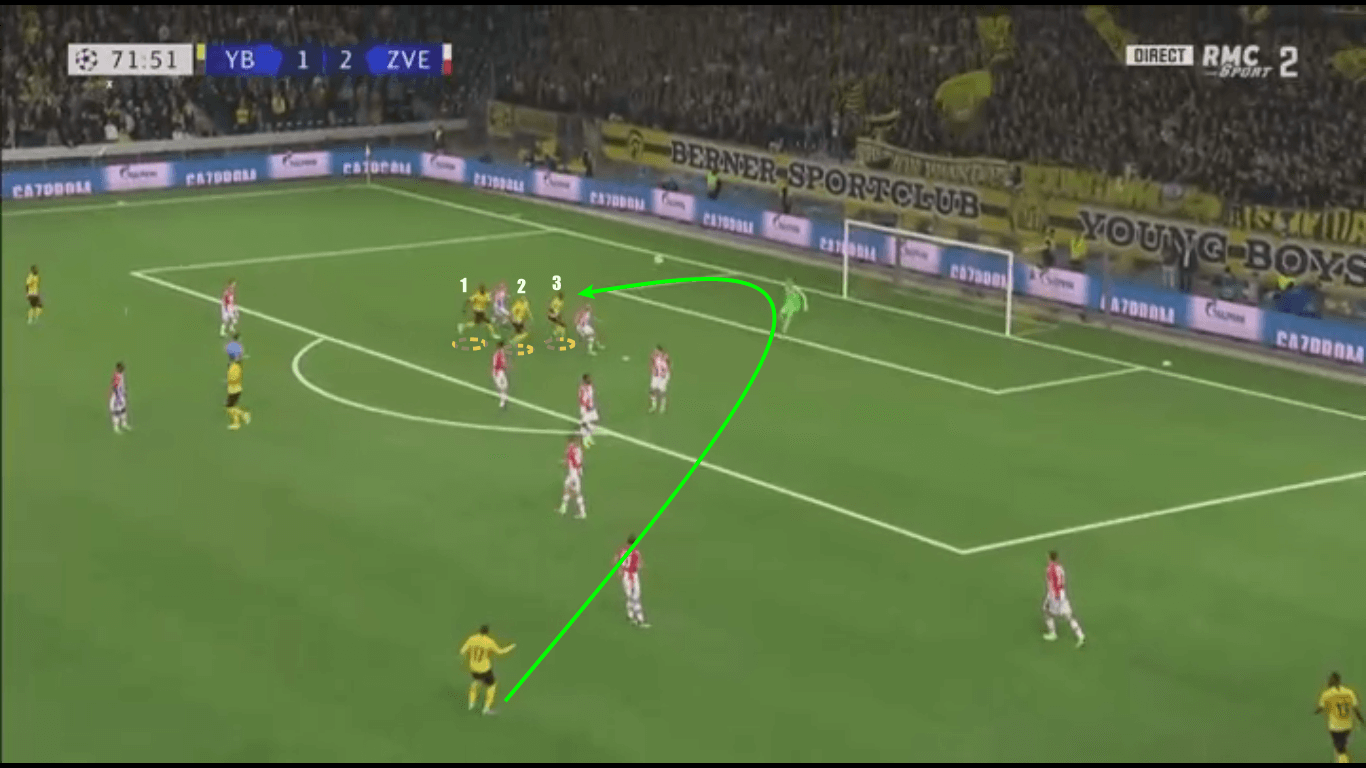
Even though they didn’t create very many chances from those situations, they kept on and on with doing them and trying to head the ball into the net. The Swiss also went into the box with no more than three players so their odds to score were lower as the opposition filled up the box with a lot more players.
Young Boys got to the equaliser from a penalty after Red Star’s defence wasn’t positioned well and were punished for the moment of recklessness.
Conclusion
Since the match was that important and the stakes were high, both teams were a little reserved and didn’t bring their best performances as is illustrated in the analysis. Young Boys had possessional superiority and controlled the match, but without big opportunities that would grant them a better result.
Red Star goes home as the happier side, they got what they wanted using strict defensive tactics and relying on individual qualities to pull them through. They scored two goals away from home and could be important for the aggregate score. But the fixture is still wide open since both they and the Swiss have a lot more to display in the second leg in Belgrade.

If you love tactical analysis, then you’ll love the digital magazines from totalfootballanalysis.com – a guaranteed 100+ pages of pure tactical analysis covering topics from the Premier League, Serie A, La Liga, Bundesliga and many, many more. Buy your copy of the August issue for just ₤4.99 here.

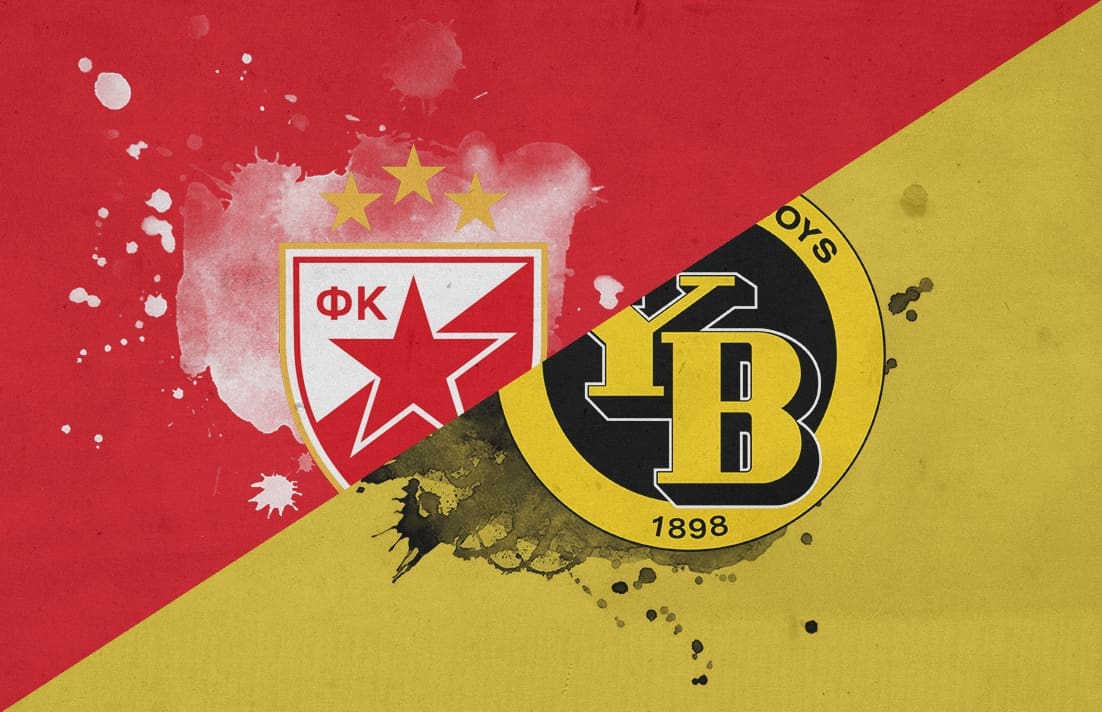


Comments